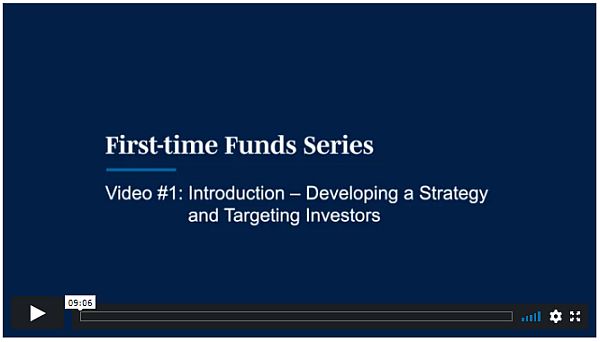- with Senior Company Executives, HR and Finance and Tax Executives
- with readers working within the Banking & Credit, Insurance and Healthcare industries
In this first video, Mike Akkawi, Lauren Hulme, Nick Germanakos and Eunice Kwon provide a brief introduction to the video series, followed by a discussion of preliminary fund formation considerations when developing a strategy and targeting investors. They discuss important considerations including:
- how a fund strategy should reflect experience and intended investor base; and
- where investments should be based, the number of investments to hold, the total enterprise value range and how much to raise relative to portfolio construction.
Play the video above to watch the informal discussion and watch the next episode of our first-time funds series on fund structures.
Click here to visit the main First-time Funds Series page.
Video Transcript
Michael Akkawi (00:06): Hello everyone, and welcome to our video series on first-time funds. I'm Mike Akkawi, head of the Private Equity group at Torys, where I focus on information matters, among other practice areas. The team and I are delighted that you are joining us for what we hope you will find to be a very interesting series of 11 videos that provide an overview and certain high-level considerations for first-time fund sponsors like you, thinking about launching your own fund. I'm joined in this first video of the series by my colleagues, Lauren, Nick and Eunice. All of whom have extensive experience on fund-formation matters. Lauren, over to you for an overview of the video series and this first video in particular.
Lauren Hulme (00:46): Thanks Mike. Hi everyone, I'm Lauren Hulme, a senior associate in our Private Equity group, and my practice focuses on fund formation, fund investments, co-investments and secondary transactions. To add to what Mike was saying, the video series includes two dozen of our lawyers who specialize in private markets funds. We range from junior associates through to partners, and from across our offices in Toronto, Calgary, Montréal and New York. This first video will include an introduction to the video series, followed by a brief discussion of certain preliminary fund formation considerations, including developing a strategy and targeting investors. Feel free to check out www.torys.com for a full list of topics and presenters in our first-time funds video series. Now, I'll turn it over to Nick to give you a taste of the type of work we do here in our Private Equity Group.
Nick Germanakos (01:42): Thanks, Lauren. Hi all, I'm Nick Germanakos. I'm an associate in our Private Equity group. I've worked on various types of transactions, including first-time fund formations like the kind we're going to be discussing in this series. In our Group, we act for a wide range of investors and sponsors (including large institutional investors like pension plans), as well as private equity shops-and we also act for smaller fund sponsors and investors. We act for clients on both sides of a private fund transaction, acting for both the sponsors (or the general partners who set up the funds and run them) and the investors (who commit capital and invest in these funds). Eunice will talk next about who we expect might be most interested in this video series.
Eunice Kwon (02:27): Hi everyone, I'm Eunice Kwon, and I'm also an associate in our Private Equity group. I've done a lot of fund formation and fund investment work for funds in both Canada and the U.S. This video series is aimed at first-time fund sponsors, who are raising capital largely from friends and family, and maybe also some capital from angel investors and high net-worth individuals. While some of the topics in this series will touch on matters that might be of more interest to fund sponsors who are raising a subsequent fund as opposed to a first-time fund, or to fund sponsors who are really seasoned in the industry, bringing in institutional investors from the time of their first fundraise, the key target market of our first-time fund program is really friends and family funds, and to ensure that you get "market" documents that will set you up for your future. I'll turn it over to Mike to discuss our program more fully.
Michael Akkawi (03:22): Great, thanks Eunice. Given that this is your first-time fund, we understand that the cost of setting up the fund will be important to you. And so, our goal is to make sure that we can offer you our services at a reasonable fixed fee. Setting our fee proposal for you will depend on a number of factors, such as the jurisdiction of you as principals-whether you're all in Canada, in Canada and the U.S., or international-the complexity of your structure, the expected jurisdiction, and sophistication of your investors. While forming a private-markets fund is not a simple exercise, because we do so many of them, we have prepared a suite of fund documents that we would expect your investors to readily accept and will also position you for future funds that may include institutional investors. So hopefully, this will have given you an overview of our group and the video series, and now we'll dive into the first topic of the series, which is developing a strategy and targeting investors. So, I'll turn it over to Lauren to kick us off on that.
Lauren Hulme (04:25): So, you've decided you want to go out there and do this yourself. You want to raise your first and your own fund. First off, congratulations! That's a big decision, and an exciting journey lies ahead. One of the preliminary considerations is that you need to choose a strategy. There are lots of fund strategies out there: buyout, venture capital, growth capital, real estate, infrastructure, debt, fund of funds, secondaries, and more. You will, of course, set up a fund in your area of expertise, and the strategy you choose should reflect your experience and your intended investor base. And if you have significant experience and a strong track record in a certain industry, investors will be more likely to trust you to operate effectively in that industry. Our advice would be to be as specific as possible in respect of your strategy. So, if you're in venture, for example, are you in life sciences, tech or health care? And if you're in health care, what kind of health care? I'll now let Nick and Eunice discuss portfolio concentration and related matters.
Nick Germanakos (05:30): Thanks, Lauren. So now you've chosen your fund strategy. Next, you should start thinking about your portfolio construction. This means thinking about questions like: where will your investments be based? That is, will they all be in Canada or North America? Or will there be a certain bucket of investments allowed to be held abroad? And if so, what will the percentage be? How many investments will you hold? Will there be a cap on the total fund's commitments that can be held in any one investment? And what will the total enterprise value per portfolio company be relative to total fund size? Investors invest in a fund in part for diversification. So, they often like to see that the fund will hold multiple investments instead of being too concentrated in just a few. Thinking about how much you want to raise in total, relative to portfolio construction is wise to help with these preliminary considerations.
Eunice Kwon (06:25): So in parallel to thinking about your portfolio construction, you should also be thinking about your investor base. Will you have any investors outside of Canada or the U.S.? When you raise outside of Canada or the U.S., you enter into a world of foreign securities laws for which you will need to be mindful. And our colleagues, Michele and Christina, will be discussing these types of considerations in more detail in Video #10. The location of investors will also drive fund structuring, which is largely tax-related. And in this video series, we won't be directly addressing tax considerations; however, our tax colleagues are always very happy to discuss general tax matters with our clients at any time. Our colleagues, Jamie and Anthony, will be discussing fund structuring in more detail in the next video.
Nick Germanakos (07:15): For our first-time funds program, as we previously discussed, it is really aimed at friends and family investors. However, we encourage you to really consider whether you will just be bringing in friends and family investors, or whether that will be expanded to any investors who would want to negotiate the fund documents or have their own side letter agreements. This is a topic that our colleagues, Colby and Mark will discuss in Video #5. The more an investor negotiates, the more complicated the fund formation and fundraise becomes. The friends and family program is really based on investors accepting a standard form of agreement that we view as consistent with market.
Eunice Kwon (07:56): And we also want to note that your investors will need to be accredited investors, given that this is a private fund. Michele and Christina, will dive into the concept of accredited investors when they discuss securities law considerations in Video #10, as mentioned. Finally, high net-worth funds or retail funds, comprised primarily of individual investors as opposed to institutional investors, are a hot and growing trend right now, including for big sponsors who generally focus on institutional investors. Our colleagues Guillaume and Ana will be discussing this topic in Video #11. I'll now turn it over to Lauren and wrap things up.
Lauren Hulme (08:37): Thanks Eunice. This first video is really just a taste of who we are and what's to come in this video series, and was also intended to get you thinking about how to get off the ground with launching your first fund. In the next video, our colleagues, Jamie and Anthony, will discuss fund structures. Please do reach out to any of us if you have any questions. We hope you enjoy the series.
The content of this article is intended to provide a general guide to the subject matter. Specialist advice should be sought about your specific circumstances.





